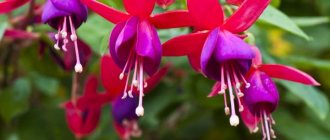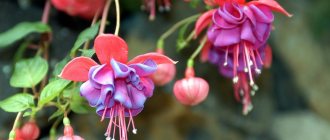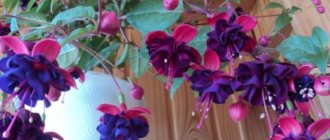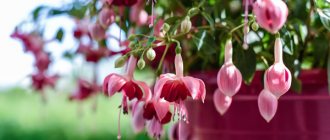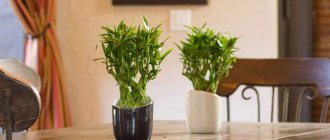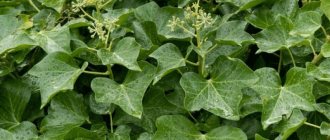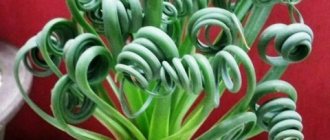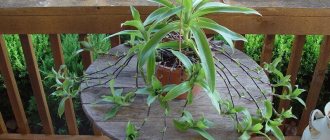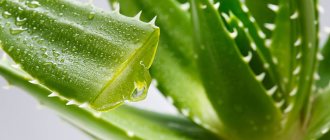Botanical description
Fuchsia is a perennial plant, shrub or low tree with small rounded, slightly elongated leaves located on thin flexible branches, a powerful root system and flowers of unusual shape.
Flowering occurs in the summer and can continue until the end of autumn. The main varieties of Fuchsia are shrubs, trees and carpets. Mostly shrubby plant species are grown at home.
Indoor Fuchsia is a relatively small branched shrub with drooping or erect branches.
REFERENCE. Particularly appreciated are those varieties of Fuchsia that can be grown as hanging plants in hanging pots.
Reproduction
Description of the seed propagation method:
- To obtain good seeds, you must ensure that the flower does not self-pollinate. To do this, the blooming mother flower is removed from the anther, the pollen of the father's flower is transferred to the stigma, and after pollination it is covered with a fabric bag. Two to three weeks after this, the fruit ripens, the seeds are removed from it and dried for three days.
- For planting, use small bowls filled with moistened soil (its composition is the same as for replanting). Seeds are planted on the surface, covered with plastic wrap and placed in a warm, well-lit place for germination. Shoots appear after three weeks.
- After a month and a half, the seedlings germinate and begin to harden; to do this, they are taken outside every day for 15 minutes. The time spent in the fresh air is gradually increased.
- After two months, the young plants are transplanted into permanent containers.
The seed method can lead to fuchsia completely losing the characteristics of the mother plant.
Propagation by seeds
You can propagate fuchsia by cuttings; this method is carried out in early spring and consists of the following steps:
- 1C plants cut young cuttings ten centimeters long (the lower leaves are removed from them) and place their lower end in water.
- 2After the roots appear (this can take up to three weeks), the young plants are planted in separate pots.
Propagation by cuttings
Fuchsia can also be propagated vegetatively:
- 1C plants cut off a leaf with a small piece of shoot, dig it into moistened soil and cover it with film.
- 2After rooting of the planting material, the film is removed and cared for as for an adult plant.
Vegetative propagation
Plant structure
Roots
The plant has a powerful and developed root system. Because of this, it easily tolerates transplantation and propagation.
An important condition for growing is constant access of air to the roots. To do this, you will have to periodically loosen the soil and use light soil.
Leaves
The leaf blades of most plant varieties are oval with a sharp tip. Although there are specimens with ovate and lanceolate leaves.
The color of the leaf blades is green (there are varieties with a reddish tint). The edge may be jagged.
The leaves grow on petioles that have a noticeable reddish tint.
Flowers
Flowers are the main decorative part of the plant. They grow on flower stalks. Depending on the variety - separately or in inflorescences. It is precisely because of the appearance of the flowers, which resemble the silhouette of a woman in a skirt, that Fuchsia is popularly nicknamed “Ballerina”.
The shape and shade of flowers may vary. There are both single-color and two- and three-color specimens.
The flower consists of sepals, petals growing in a tube, and long yellow stamens.
To the touch, the petals can be simple or terry.
INTERESTING. In some countries, Ballerina flowers are used to decorate culinary dishes, mainly desserts and salads.
Fruit
It bears fruit with small dark, slightly elongated berries, similar to chokeberries.
Unlike most other houseplants, Fuchsia fruits are edible. They taste sweet, slightly tart. In countries where Ballerina grows naturally, a variety of tinctures, liqueurs and jams are prepared from its fruits.
History of fuchsia
The fact that we can see beautiful fuchsia flowers on our windows is due to the French monk Charles Plumier, a botanist and passionate traveler. At the end of the 17th century he went to travel to South America. There, in Santo Domingo, he saw a beautiful flowering bush. Plumier named the unknown plant fuchsia - in honor of the famous German doctor and botanist Leonard Fuchs. However, fuchsia came to Europe only a few decades later.
In the time of our grandmothers, this extremely beautiful plant was not at all rare. Along with geraniums and balsams, fuchsia adorned every window. And then fuchsia, like the notorious pelargonium and ficus, suffered due to the ideology being pursued in the country and was recognized as an attribute of bourgeois life.
Signs and superstitions associated with Fuchsia
It is no wonder that such an unusual plant as Fuchsia is associated with so many interesting signs and beliefs.
- Fuchsia protects the house from negative external influences.
- The ballerina is the patron saint of creativity and creative professions.
- Gypsy earrings can be safely given to newlyweds and new residents. Fuchsia will help them improve their life in their new home.
- Women who want more male attention need to take a very responsible approach to caring for the Ballerina. The more magnificent the flowering, the more compliments and gifts from the stronger sex.
- The flower has a calming effect on the nervous system, allowing you to collect your thoughts and prepare for making an important decision.
- The plant is believed to help cope with gastrointestinal diseases.
- An unpleasant superstition. Sometimes the plant is called "Widow's Tears". Because of this, it is not recommended to grow it for women whose husbands work in dangerous jobs.
INTERESTING. According to legend, Fuchsia appeared when a wizard bewitched seven sisters who refused to become his concubines.
Flower varieties
Fuchsia is loved not only by flower growers, but also by breeders. Over the entire period that the flower has been a cultivated plant, many varieties and hybrids have been bred. Every year more and more specimens appear, differing in the shade and size of the flowers, the shape of the leaves, etc.
In flower shops in our country you can most often find the following varieties:
- Brutus . One of the most popular varieties. It is a small bush. The inner petals of the flowers are purple, and the outer petals are scarlet.
- Deep Purple . A variety with drooping branches and large double flowers of deep purple color.
- Checkerboard . It is distinguished by erect, slightly branched shoots and red and white flowers.
- Bella Rozella . The peculiarity is the iridescent pink hue of the flowers.
- Leonberg . The petals of this variety are pink, but the bracts have a different shade
Plant care
Having bought Fuchsia, it needs to be quarantined for a while. After the plant gets used to its new home, it is advisable to replant it.
Fuchsia does not like heat. Optimal conditions are 20 – 25 degrees. If the apartment is too hot, the room needs to be ventilated and the flower needs to be sprayed.
IMPORTANT! In winter, ventilation must be carried out carefully, since the Ballerina cannot tolerate drafts.
The flower loves light, but can only tolerate direct rays of the sun on a balcony or veranda. Where the wind can cool the leaves.
In winter, the plant needs rest. At this time of year, the flower pot is transferred to a cool room, dry leaves and branches are cut off. Watering is carried out very rarely. Approximately once a month.
In the spring, transplanting and pinching are carried out.
Fuchsia blooms in summer. At this time, Ballerina needs to be regularly watered and fed.
More information in our article “How to care for Fuchsia at home: all the subtleties of growing.”
KaviCom.ru Internet portal of Stary Oskol
Where did it even come from, this fuchsia that conquered millions of hearts? We owe this to the French missionary botanist Charles Plumier, who, in the mid-17th century, went to the American continent in search of the homeland of the cinchona tree. We do not know whether he managed to cope with the task, but among other finds, the traveler accidentally discovered a flower of rare beauty, and named it in honor of the then famous German botanist and physician Leonard Fuchs Fuchsia triphilla flore coccinea.
There is no plant more versatile and diverse. The flower “named after Fuchs” can be grown in hanging baskets, formed into a standard tree, bonsai, or simply a beautiful lush bush. At the end of the 18th century, fuchsias over three meters high were grown in rich European palaces and winter gardens, giving them a pyramidal or columnar shape.
When I got the Internet, of course, I found fuchsia collectors and was simply amazed: how many color options there are! From pure white to almost black, there is no such thing as just yellow flowers. The nearest collector was in the neighboring Voronezh region, and as soon as the snow cleared from the roads, I went there. The impressions were through the roof: two huge greenhouses housed about 300 varieties of fuchsias, another greenhouse with pelargoniums and a bunch of shelves with violets. I still regret that I went without a camera. I couldn’t leave there without my favorites.
I placed my overseas beauties on the glassed-in balcony. I hung blinds on the windows to shade them from the bright sunlight. Fuchsias do not tolerate direct sunlight. The optimal conditions for its maintenance from spring to autumn are coolness, bright diffused light and moist air. When spraying my flowers, I follow the rule: the higher the air temperature, the more often I spray. Fuchsias very often die in the summer from overheating of the roots, which is what happened to me last summer. About 30 varieties “burned out” in a few days.
In order for fuchsias to bloom profusely from spring to autumn, they need a cool winter. The temperature in winter should be +4 –+ 10C, but not lower than 0. When the earthen clod freezes, the plant will inevitably die.
In order for fuchsia to grow as a beautiful lush bush, it needs to have a “hairstyle”. To do this, in early spring you need to prune the plant, followed by pinching the branches after every second or third internode. But don’t get carried away, because you will see buds about a month after the last pinching.
I'll say a little about watering. For myself, I found a golden mean: in the summer, water a little, but more often; in winter - a little, but less often.
Many centuries have passed, but even now on the windowsills of rural houses and city apartments you can find an amazing plant called “gypsy earrings”, “dancing ballerinas”, “maiden beauty” or simply Fuchsia.
